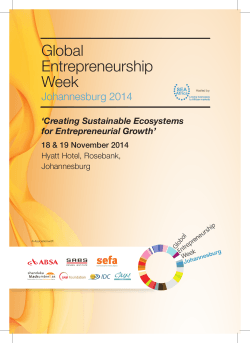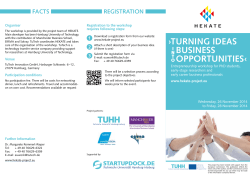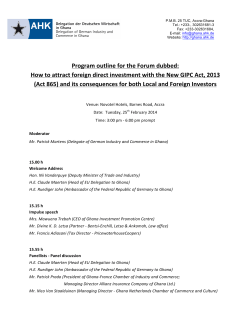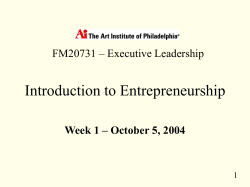
Savings, entrepreneurial trait and self
Peprah et al. Journal of Global Entrepreneurship Research (2015) 5:1 DOI 10.1186/s40497-015-0017-8 RESEARCH Open Access Savings, entrepreneurial trait and self-employment: evidence from selected Ghanaian Universities James A Peprah, Clifford Afoakwah and Isaac Koomson* * Correspondence: koomsonisaac@gmail.com Department of Economics, University of Cape Coast, Cape Coast, Ghana Abstract Youth unemployment is a major setback to sustainable growth. In recent times, Ghana has experienced a downward trend in youth employment in spite of several attempts made by the government to control the unemployment situation. This paper explores savings behaviour, entrepreneurial trait and the decision to be self-employed among students from selected public and private universities in Ghana. Employing the bivariate analysis and probit model on a sample of 1046 students shows that savings behaviour among the youth varies according to their programmes of study, type of institution (public and private) and family background of the students. Savings and entrepreneurial trait increase the probability of self-employment decision among university students. Policies that can address graduate unemployment should focus on helping students to save while in school. Also, incorporating entrepreneurial training into the academic programmes of these institutions has the tendency of improving the entrepreneurial traits of students and thereby, decide to be self-employed. Policy intervention needs to be designed strategically to target students into self-employment as a way of curbing youth unemployment in Ghana in order to contribute to national development. Keywords: Entrepreneurial trait; Ghana; Youth unemployment; Savings; Self-employment Background The labour market in Ghana is fragmented with sub divisions of informal and formal sectors, with the informal markets being very substantial and largely consisting of self‐ employed entrepreneurs. The formal sector generates employment for a large number of young people (Maloney, 2004; Munive, 2010). However, Naudé (2008) asserted that the formal sector consists of wage employment and is characterised by high unemployment rates. In Ghana, wages in the formal sector are low relative to the high cost of living, with these low wages often being blamed for the low productivity in the economy, providing little incentive to work. The wage structure in the public sector, coupled with inefficient supervision, offers little incentive to improve skills and productivity (Aryeetey and Baah‐Boateng, 2007). Despite the low wage offered in the formal sector, governments as well as donor initiatives (such as the ‘Africa Commission 2009’) focus on employment in the formal sector to the neglect of other informal means of youth employment (mainly, self-employment). © 2015 Peprah et al.; licensee Springer. This is an Open Access article distributed under the terms of the Creative Commons Attribution License (http://creativecommons.org/licenses/by/4.0), which permits unrestricted use, distribution, and reproduction in any medium, provided the original work is properly credited. Peprah et al. Journal of Global Entrepreneurship Research (2015) 5:1 According to Aryeetey and Baah-Boateng (2007), while Ghana has witnessed an average economic growth of 5.1 percent in the past two decades, the country has not witnessed any corresponding growth in employment during that period. This is because the country’s economic growth was in the services sector such as banks which employed a limited number of people instead of growth in the agricultural and manufacturing sectors which had the potential to create employment for a larger number of people. The authors found that 23 percent of youth between the ages of 15 and 24 and 28.8 percent of graduates between the ages of 25 and 35 wait for two years or more before they get employed. This situation often creates unemployment particularly among the educated youth. The unemployment rate in Ghana has increased from 2.8% in 1994 to a high rate of 10.5% in 2000, and the situation was worse among the youth and in urban areas (Aryeetey and Baah‐Boateng, 2007; Munive, 2010). In 2001 this figure increased to 11.2% and further to 12.9% in 2005 (Ghana Statistical Service 2008). This shows an increasing trend in unemployment in Ghana. Realizing the unemployment problem faced by the youth, the government in 2006 established the National Youth Employment Programme (NYEP) to provide employable skills, work experience and employment to the youth. The politicization of the programme has not made it fulfil its dream. In 2011 another programme that targets the unemployed was introduced by the, then, president of Ghana (Local Enterprise and Skills Development Program (LESDEP)). This programme has the aim of training the unemployed to acquire viable skills that will eventually make them self-employed through a specialized hands-on training, within the shortest time possible in their localities. Like NYEP, LESDEP also has its own political hindrances. The Youth in Agriculture Programme (YIAP) also faced similar challenges. The implication is that in Ghana, government programmes have not been effective in addressing youth unemployment problems. With government interventions not living up to expectation, the private sector has now become the beacon of hope to absorb the unemployed in the economy in various sectors of the economy – formal and informal sectors. The 2010 Population and Housing Census (PHC) shows that 85 percent of the Ghanaian population are into private informal activities while the remaining 15 percent are into formal sector activities. It must be emphasised that these private informal businesses are largely small and medium scaled as has been documented by Quartey and Abor (2010). Their argument is that 92 percent of businesses in Ghana are SMEs that also provide about 85% of manufacturing employment. The private sector’s role in solving the problem of unemployment is also impeded due to the problem it faces in terms of access to credit, which ranks as the topmost. In Ghana, access to finance has been the major impediment to SME development (Carpenter, 2001; Anyanwu, 2003; Lawson, 2007). Faced with problems in accessing finance, the option available to these SMEs is internal finance which is largely made of savings (World Bank Enterprise Survey – WBES, 2007). SMEs financed internally is 86.5 percent in Ghana; 78.4 percent in Sub-Saharan Africa (SSA) and 71.4 percent in the world. On the contrary, the proportion of SMEs working capital financed by banks is seven percent in Ghana; 9.9 percent in SSA and 12 percent in the world (The Word Bank 2007). Most people who have business ideas are unable to start these businesses because they do not have the needed capital. There is the need for a paradigm shift to the solution by making funds available for self-employment. Page 2 of 17 Peprah et al. Journal of Global Entrepreneurship Research (2015) 5:1 Self-employment is a form of labour market status which may encompass a wide range of different activities. Individuals may choose to be self-employed for different reasons, and as a result the self-employed group may be highly heterogeneous. At one end of a possible spectrum, the self-employed may be identified as entrepreneurial, single employee micro-businesses. A substantial body of research investigates the self-employed as entrepreneurs, using self-employment as an observable category which, albeit imperfect, identifies the stock of entrepreneurial talent in the economy. At the other end of this spectrum, self-employment may comprise a far less desirable state chosen reluctantly by individuals unable to find appropriate paid employment under current labour market conditions. So, for example, individuals wanting flexible working hours might choose self-employment if a paid employment contract offering sufficient flexibility is unavailable (Dawson et al. 2009). Provision of star-up capital can be made available by inculcating savings behaviour in university students to enable them to accumulate the needed capital to start their own business after school. In recent years, politicians, policy makers, donors, and financial service providers have been paying more attention to the youth and their access to financial services because savings has been described as one of the important sources of capital formation (Kilara and Latortue, 2012). Another key issue to the determinant of self-employment is entrepreneurial trait, thus, the mechanism that drives the ability to behave as an entrepreneur. The study by (Korunka et al. 2003) as well as Shook, Priem and McGee (2003) identified three main types of entrepreneurial traits that affect business start-up and performance. These include need for achievement, locus of control, and risk taking propensity of the individual. These factors also affect one’s decision to become self-employed. Some authors have argued that entrepreneurship education is one of the vital determinants that could influence students’ career decisions (Kolvereid and Moen 1997; Peterman and Kennedy, 2003). According to Alstete (2003) and Cassar (2007), desire for independence with related factors such as autonomy and greater control is often considered as the main motivating factor for many people in becoming entrepreneurs (Borooah and Hart 1999; Fox and Tversky 1998). With the increasing youth population coupled with increasing self-employment among Ghanaian youth, the question therefore is does savings and entrepreneurial trait among public and private university students affect their decision to be entrepreneurs? This study therefore seeks to answer this question by investigating the effect of savings and entrepreneurial trait on self-employment among public and private university students in Ghana. The main objective of the paper is to examine the determinants of self-employment among university students in Ghana. Specifically the study tested the following hypotheses: 1. Self-employment decision varies across socio-economic and individual level characteristics 2. Youth savings affects self-employment decision among public and private university students in Ghana 3. Entrepreneurial trait affects self-employment decision among public and private universities in Ghana Page 3 of 17 Peprah et al. Journal of Global Entrepreneurship Research (2015) 5:1 The remaining parts of this study are structured as follows: the next section focuses on related studies on entrepreneurial trait and self-employment; section three also discusses the determinants of self-employment decision; section four explains the methods used for the study; section five discusses results and the final section concludes. Literature review on entrepreneurial trait and self-employment The theoretical history of self-employment trace back to Gilad and Levine (1986), who argued that there are two main theories that influence an individual to start his or her own business. These are the “push” theory and the “pull” theory. The “push” theory as they asserted are the factors that force entrepreneurs into behaving entrepreneurially by negative external forces, such as one or a combination of the following, job dissatisfaction, difficulty in finding employment opportunities, unsatisfactory salary, or inflexible work schedule. These factors are a form of reactive measures. The “pull” theory on the other hand are considered as the factors that draw individuals into starting their own business by seeking independence, self-fulfilment, wealth, and other desirable outcomes. Investigating Gilad and Levine’s (1986) theory on self-employment, Keeble, Bryson and Wood (1992) as well as Orhan and Scott (2001) found that individuals become entrepreneurs primarily due to “pull” factors, compared to “push” factors. The study by Korunka, Franck, Lueger, and Mugler (2003) as well as Shook, Priem, and McGee (2003) identifies three main types of entrepreneurial traits that affect business performance. These include need for achievement, locus of control, and risk taking propensity of the individual. These factors also affect one’s decision to become self-employed. Some authors have argued that entrepreneurship education is one of the vital determinants that could influence students’ career decisions (Kolvereid and Moen, 1997; Peterman and Kennedy, 2003). Therefore, the decision to become self-employed, all other things being equal, is likely to be influenced by entrepreneurial education students have received in school. Entrepreneurship education produces self-sufficient, enterprising individuals. For example, Charney and Libecap (2000) showed that, on the average, graduates of the Berger Entrepreneurship Programme were three times more likely to be involved in the creation of a new business venture than were their nonentrepreneurial business school cohorts. Specifically, entrepreneurship training increased the probability of an individual being instrumentally involved in a new business venture by 25 percent over non-entrepreneurship graduates. In a study by Franke and Luthje (2004), the authors concluded that lack of entrepreneurial education leads to low level of entrepreneurial intentions among students. This implies that the nature of programmes and the content of school curriculum to a large extent determine the entrepreneurial trait of students. According to Alstete (2003) and Cassar (2007), desire for independence with related factors such as autonomy and greater control are often considered as the main motivating factors for many people in becoming entrepreneurs (Borooah and Hart 1999; Fox and Tversky 1998; Wilson et al., 2004). De Martino and Barbato (2003) as well as Rosa and Dawson (2006) recognise monetary motivation to self-employment as a pull factor. Even though individuals are not always motivated by money to behave entrepreneurially, the desire to get money leads them to establish their own business. The authors’ idea on monetary motivation of selfemployment is embraced by Kirkwood (2009). For the purpose of this study we limit Page 4 of 17 Peprah et al. Journal of Global Entrepreneurship Research (2015) 5:1 ourselves to the “pull” factors as a measure of entrepreneurial trait. The reason is that most of the youth in tertiary institutions are yet to have access to formal jobs. Determinants of self-employment The issue about self-employment has attracted attention from a number of researchers some of which concentrate on the decision to be self-employed. Research has identified two main constraints to becoming self-employed. These are the liquidity (financial) constraint and human capital accumulation constraint (Dunn and Holtz-Eakin, 2000). Investigating employment, Rees and Shah (1986) used a sample of 4,762 individuals retrieved from the General Household Survey for 1978 in the UK to determine the probability of self-employment. They found a positive selection bias in the observed earnings of employees. This means that the probability of self-employment depends positively on the earnings-difference between the two sectors and that education and age are significant determinants of self-employment. This study controls for the human capital effect on selfemployment without controlling for liquidity constraint that influence the decision to be self-employed. Investigating the character of self-employment using survey evidence from six transition economies, Eaerle and Sakova (2000) found that employers respond strongly to predicted earnings premia while own account responds was estimated to negative, an indication that individuals may be pushed into own account status by lack of opportunities. To support this finding, Clarke and Drinkwater (2000) adopted a framework in which self-employment decision was modelled to be influenced by ethnic-specific attributes as well as sectorial earnings differentials. Their results showed that, differences in an individual's predicted earnings in paid and self-employment are strongly correlated with self-employment decisions. Like Rees, and Shah (1986) and Clarke and Drinkwater’s (2000) study, this study did not put into consideration the role that entrepreneurial trait as a well as savings play in the decision to be self-employed. Again, these studies were conducted in developed economies where the systems in the labour market completely differ from those of developing economies like Ghana and were also not specific to the youth. Moreover, these studies consider one side of self-employment by considering only the human capital determinant of self-employment. Hence these factors, unless tested, cannot be concluded to influence the decision to be self-employed in Ghana. Another study on self-employment is that by Ahmed et al. (2010) who examined the determinants of entrepreneurial career intention among business graduates in Pakistan. Employing descriptive statistics and Pearson’s correlation coefficient on a sample of 276 university students, they found a strong relationship between innovativeness and entrepreneurial intentions. However, they observed that demographical characteristics such gender and age, were insignificant with the intentions to become entrepreneurs in Pakistan. Prior experience, family exposure to business and level of exposure rather had significant relation to students becoming entrepreneurs. This study however considers a small sample size which may lead to bias estimates. In India, Sharma and Madan (2014) conducted a study on the effect of individual factors on youth entrepreneurship. Using Cross tabulation and Chi-square test, they found that past self-employment experience has a negative impact on student’s entrepreneurial inclination. They also found no relationship between the work experience (typically less than 3 years) and entrepreneurial inclination. However, the use of cross tabulation Page 5 of 17 Peprah et al. Journal of Global Entrepreneurship Research (2015) 5:1 and chi-square test to find the effect of these individual factors on youth employment is questionable. This is because chi-square test as a non-parametric test is used to show association between two categorical variables and not the effect on one variable (independent) on another (dependent), hence weakening the reliability of their results. In SSA, some studies have been conducted to show that youth employment is a problem in both public and private sectors. For example, a study in Côte d’Ivoire supported the idea for public sector employment but indicated that there is much emphasis on social capital than human capital to deciding who is employed. This serves as a barrier to youth employment in Côte d’Ivoire, especially in the public sector. Even though the study provides useful recommendations for policy, it does not offer solution to the problem of youth unemployment, especially when the informal sector is the major employer and engine of growth in SSA. Although there are limited studies in Ghana on self-employment, a recent study conducted by Wongnaa and Seyram (2014) with the objective of investigating the factors that influence polytechnic students’ decision to graduate as entrepreneurs. Employing the Maximum Likelihood Estimation technique (MLE) specifically a probit model, they observed that personality factors such as extraversion, neuroticism, and agreeableness, support from family members and friends, occupation of parents, entrepreneurship education, gender and access to finance have significant positive effect on polytechnic students’ decision to graduate as entrepreneurs while students’ care about public remarks on their decisions has a significant negative effect on their decision to be self-employed. This study is limited by scope by focusing only on student from Kumasi polytechnic to the neglect of other polytechnics as well as other tertiary institutions. In addition, this study neglects the liquidity constraint factor to determining self-employment among the youth. Acknowledging the importance of human capital in the employment process, Sackey (2005) studied the effect of education on female employment in Ghana. Using data from the fourth round of the Ghana Living Standard Survey (GLSS), an econometric analysis of 7,200 women revealed that female schooling had positive impact on women labour market participation. Sackey considered only human capital as the constraint in labour market participation to the neglect of other constraints such as liquidity. His paper is gender-biased because he did not control for gender dynamics in the labour market participation. From the review of literature it is obvious that there exist research gaps in the form of inadequate literature on self-employment especially the case of Ghana. Most of the studies conducted consider the human capital constraint to the neglect of liquidity constraint to becoming self-employed. It is in this direction that this study seeks to control for both liquidity and human capital constraints that influence self-employment. In line with the above, we investigate the effects of youth saving and entrepreneurial trait on the decision to be self-employed among university students in Ghana. Methods Population The population for the study constituted all university students in private and public universities in Ghana. Public and accredited private universities that have been in Page 6 of 17 Peprah et al. Journal of Global Entrepreneurship Research (2015) 5:1 Page 7 of 17 existence for more than ten years and above were considered. These public universities are University of Cape Coast (UCC), Kwame Nkrumah University of Science and Technology (KNUST), University of Ghana (UG), University of Education Winneba (UEW), University of Mines and Technology (UMaT), University of Professional Studies, Accra (UPSA), University for Development Studies (UDS), and Ghana Institute of Management and Public Administration (GIMPA). The accredited private universities that constitute our population are Valley View University College (VVUC), Methodist University College (MUC), All Nations University College (ANUC), Catholic University College (CathUC), Pentecost University College (PUC), Central University College (CenUC), Presbyterian University, Garden City University College (GCUC), Ashesi University and Zenith University College (ZUC) Sample and sampling technique The study used a multi-stage sampling technique to sample 1,200 students from selected Ghanaian universities. The first stage was to use convenience sampling to select seven public universities out of the eight and four private universities out of the ten. Having identified the various universities, the second stage adopted simple random sampling process to select the students who participated in the study. Because of difference in students’ population size among public and private universities, the study sampled 70% of the estimated 1,200 students from public universities because they have a greater proportion of students according to the National Accreditation Board, Ghana. The remaining 30% was sampled from the five private universities. The study selected 120 students from each of the seven selected public universities making 840 students. Among the four selected private universities, 90 students from each of them making 360 students were selected. The simple random sampling technique was employed because it provides all entities in the population a non-zero chance of being part of the study. Also, due to its probabilistic nature, simple random sampling reduces biasedness making results reliable and generalizable. Theoretical and empirical models The study uses the occupational choice model drawn from (Parker, 2004) to determine the decision to become self-employed. Suppose an individual is chosen from a crosssectional data such that there are two occupations (denoted by j) to choose from: wage employment (W) and self-employment (S). Each individual has a vector of observed characteristics Xi and derives utility Uij = U(Xi : j) + ɛij if they choose occupation j where U is observable utility and ɛij idiosyncratic unobserved utility. The relative advantage to self-employment (S) is defined as: yi ¼ U ðX i ; S Þ−U ðX i ; W Þ−εiS þ εiW ð1Þ 0 Assuming that U (;) is linear taking the form U ðX i ; jÞ ¼ βj X i where βj are vectors of coefficients then we can write: 0 yi ¼ α þ β X i þ vi ð2Þ From (1) individual i chooses self-employment over paid employment if yi > 0 or otherwise if yi ≤0.The observable occupational indicator variable is defined as follows: Peprah et al. Journal of Global Entrepreneurship Research (2015) 5:1 yi ¼ 1 if individual i is observed in S 0 if individual i is observed in W Page 8 of 17 ð3Þ Therefore the probability that a student with characteristic vector Xi is drawn from the population and appears in the sample is: ð4Þ Prðyi ¼ 1Þ ¼ Pr yi > 0 The maximum likelihood estimation technique specifically the probit model was used to model self-employment decision among university students. In doing this, we specified the decision to be self employed as a function of student characteristics including savings, entrepreneurial trait, gender, place of residence, current employment status, family business and type of university. The choice of the use of probit model was justified because of the dichotomous nature of the dependent variable. The decision to engage in self-employment was estimated using equations 5, 6 and 7. Model 1 (full model) Self empi ¼ γ þ δSavi þ ΩEnt trait i þ πUrban þ αMale þ φFam bus þ ϑEmployed þ τReg i þ βPublic þ εi ð5Þ Due to differences in the characteristics between public and private institutions and the heterogeneity in family backgrounds savings and balances in accounts of students in public and private institutions, it is prudent to run two separate models for public and private institutions. Model 2 (public university) Self pubi ¼ γ þ δSavi þ ΩEnt trait i þ πUrban þ αMale þ φFam bus þ ϑEmployed þ τReg i þ εi ð6Þ Model 3 (private university) Self privi ¼ γ þ δSavi þ ΩEnt trait i þ πUrban þ αMale þ φFambus þ ϑEmployed þ τReg i þ εi ð7Þ The apriori expectations are as follows δ > 0; Ω > 0; π > 0; α >< 0; φ > 0; ϑ < 0; τ >< 0; β > 0 Definition, measurement of variables and estimation technique Self-employment (Selfemp) is captured as one if the individual is willing to start his or her own business, and zero if otherwise (wage/hired occupation). Savings (Sav) is the current balance in individual’s savings account and it is a continuous variable. Enttrait is a continuous variable that measures the entrepreneurial trait of the student. Entrepreneurial trait is an index generated from a five-point Likert scale. Questions capturing the extent to which students attach importance to pull factors or entrepreneurial indicators (need to achieve, locus of control, risk taking propensity, seeking independence, self-fulfilment, wealth creation, autonomy) to become an entrepreneur. The index Peprah et al. Journal of Global Entrepreneurship Research (2015) 5:1 Page 9 of 17 ranges from 1 to 35. The closer the index is to 35, the higher the level of entrepreneurial trait. Urban (Urban) controls for residential differences and it is captured as one if the student resides in an urban area and zero if otherwise. Male (Male) is a variable controlling for gender difference. It is captured as one for male student and zero if otherwise. Family business (Fam_bus) is whether the student has a family member who owns business. Employment status (Employed) is a dummy variable measured as one if the student is working while schooling and zero if otherwise. We also include regional (Reg) dummies to control for differences in regions that might influence the decision to be self-employed. In model 1, we model self-employment decision for university students in Ghana. In model 2 and 3, we model self-employment decision for public university and private university students respectively. All three equations are estimated using the maximum likelihood estimation (MLE). Specifically, the employed the probit model because the dependent variable is dichotomous and satisfies the assumptions underlying the maximum likelihood estimation technique (Cameron and Trivedi, 2010). The chow-test by Gregory Chow is used to test for difference in the coefficient emanating from models 2 and 3. This test is used to test whether the coefficients in the two regressions are equal (Chow, 1960). The student t statistics is employed to test for the first two hypotheses while the chi square test is used to test for the third hypothesis. Results and discussion Descriptive statistics 80 The decision to start own business varies across academic programmes of study (Figure 1) and the test statistics indicate that students reading business-related programmes are more likely (37%) to start their own business than those studying science programmes (30%). Twenty-five percent of students representing those in the Arts and Humanities are likely to start their own businesses after school. This outcome stems from the fact that the curricula of the business related programmes are structured in ways that include more entrepreneurship-oriented courses and in the end, equip students with the know-how as regards business start-ups and enlightens them about the benefits of owning their own business. 75% 70% 40 60 63% 37% 30% 0 20 25% Sciences Business Not Sart Own Business Pearson chi2(2) = 10.6466 Arts/Humanities Start Own business Pr = 0.005 Figure 1 Self-employment and academic programme. Source: Field survey, 2014. Peprah et al. Journal of Global Entrepreneurship Research (2015) 5:1 Page 10 of 17 80 This inference is supported by Charney and Libecap (2000) who showed that graduates who had obtained entrepreneurship training were three times more likely to be involved in the creation of a new business venture than non-entrepreneurial business school cohorts. It is an undeniable fact that business programmes are entrepreneurial oriented. In Ghana, most business schools teach courses such as entrepreneurship, financial management, business management, accounting and finance and microfinance. All these programmes have the potency of equipping students with entrepreneurial trait. The male-female decision to start own business (Figure 2) shows that 33 percent of male students desire to start their own businesses while 67 percent do not intend to do so. Compared to their female counterparts, 30 percent of female students desire to start their own business while 70 percent do not intend doing so. This finding is not surprising because earlier studies have confirmed the tendency for males to be more entrepreneurial minded than females. This confirms the finding of Furdas and Kohn (2010) that showed that women participate less in entrepreneurial activity than men. Women might be more risk averse than men and for that reason may not be able to venture risky businesses. It is important to state that going into own business needs a bold decision and women by their nature may not be prepared to venture the risk because they are risk-averse (Croson and Gneezy, 2009). Savings is very crucial to business start-ups. Figure 3 displays account ownership and the mean savings amount of students in both public and private universities. It was found that 89 percent of students in public institutions do not own accounts while 11 percent own accounts. 82 percent of the private university students own accounts while the remaining 18 percent do not. The savings amounts of students show that students in private universities, on the average, save more (GH∝ 1,464.28), than students in the public universities (GH∝ 866.67). This, by inference, means that students from the private institutions will have greater desire to own their businesses than their counterparts from the public universities. The accumulation of savings has been cited to influence attitudes and behaviour in positive ways that could help one to start a business (Johnson et al., 2013) since savings 70% 40 60 67% 33% 0 20 30% Male Female Not Start Own Business Pearson chi2(1) = 0.7550 Start Own Business Pr = 0.385 Figure 2 Decision to start own business by sex. Source: Field survey, 2014. Peprah et al. Journal of Global Entrepreneurship Research (2015) 5:1 1,500 89% Page 11 of 17 GHC 1,464.26 20 1,000 GHC 866.672 500 40 60 Mean of Savings Amount 80 82% 18% 0 11% private 0 public Have Savings A/C No Savings A/C Pearson chi2(1) = 10.5195 public private Pr = 0.001 Figure 3 Account ownership and Mean Savings Amount by Institution. Source: Field survey, 2014. serves as the basis for initial capital to students who intend to start their own business (Scanlon and Adams, 2008). The decision to be self-employed is heterogeneous for students across regions in Ghana (Table 1). It can be deduced from the Table 1 that out of the 31 percent of students who want to start their own business, majority (38%) across the board hail from the Central and Northern regions and the least (14%) hail from the Upper West region. Econometric results: savings, entrepreneurial trait and self-employment Table 2 shows three main models: full sample for public and private universities, public universities and private universities respectively. The differences in collected sample size of 1200 students and the regression sample size 1046 emanates from missing observation on certain variables in the model. The study uses robust standard errors to correct for any heteroskedasticity that might exist in the models. For perfect multi- Table 1 Decision to be self-employed across regions in Ghana Decision to start own business Region Yes (%) No (%) No response (%) Total (%) Western 30 67 2 86 (100%) Central 38 58 4 108 (100%) Greater Accra 33 63 4 500 (100%) Volta 30 70 0 27 (100%) Eastern 25 69 6 84 (100%) Ashanti 26 70 4 163 (100%) Brong Ahafo 26 65 9 80 (100%) Northern 38 63 0 8 (100%) Upper East 14 86 0 7 (100%) Upper West 33 67 0 3 (100%) No response 21 71 9 34 (100%) Total 31 65 4 1100 (100%) Source: Field survey, 2014. Peprah et al. Journal of Global Entrepreneurship Research (2015) 5:1 Page 12 of 17 Table 2 Regression results Self-employment Entrepreneurial trait Savings Male Urban Employed Family business Public Model 1 Model 2 Model 3 Full sample Public Private Marginal effect Marginal effect Marginal effect 0.018 0.024 −0.001 (1.94) (2.22) (-0.03) 0.016*** 0.015** 0.017** (3.04) (2.44) (2.03) −0.025 −0.047 −0.036 (-0.84) (-1.36) (-0.61) −0.075* 0.002 −0.211*** (-1.89) (0.04) * ** (-3.07) −0.141 −0.123 −0.196** (-2.99) (-2.21) (-2.10) *** ** −0.055 −0.081 0.030 (-1.76) (-2.29) (0.49) 0.139 - - −0.027 −0.034 0.159 (-0.48) (-0.58) (0.94) 0.051 0.025 0.124 (0.97) (0.44) (0.99) −0.039 −0.002 −0.181 (-0.42) (-0.02) (-0.92) −0.080* −0.051 −0.098 (-1.76) (-0.73) (-1.40) −0.060 −0.028 −0.239*** (-1.38) (-0.60) (-2.61) −0.123** −0.217*** −0.049 (-2.36) (-3.77) (-0.52) 0.020 −0.022 - * ** (4.41)*** (Base = Greater Accra) Western Central Volta Eastern Ashanti Brong Ahafo Northern (0.13) (-0.14) Upper East −0.227 −0.200* (-1.79) (-1.76) Upper West 0.076 0.087 (0.26) (0.31) Constant 0.235 0.325 1.386** (0.14) (0.85) (2.03) 0.463 0.612 0.302 Goodness of fit test 0.2673 0.2128 0.301 Chow test 0.000 N 1046 733 313 Link test t statistics in parentheses. * p < 0.1, **p < 0.05, ***p < 0.01. Source: Field survey, 2014. - - Peprah et al. Journal of Global Entrepreneurship Research (2015) 5:1 collinear variables, one is dropped to avoid biased estimates. Regions such as Northern, Upper East and Upper West are dropped from model 3 because of multicollinearity. Considering the null hypothesis, the models are correctly specified and that there is no unobserved heterogeneity. In addition, employing the Hosmer-Lemeshow goodness of fit test, the three models passed and are therefore fit and reliable (Table 2). The p-value of the chow test suggests that the null hypothesis that the coefficients in models 2 and 3 are equal is rejected implying that the differences in beta coefficients in both models emanate from differences in characteristics of students in public and private universities. Entrepreneurial trait significantly predicts the decision to be self-employed. In the full model, an increase in entrepreneurial trait among these youth increases their probability to be self-employed by 0.018, all other things being equal (Table 2). This supports the results by Alstete (2003) and Cassar (2007) that entrepreneurial trait is considered as the main motivating factor for many people in becoming self-employed. It is also in line with the findings by Shepherd and DeTienne (2005) that there exists positive relationship between entrepreneurial knowledge and identification of entrepreneurial opportunities. The sub-sample regression revealed that entrepreneurial trait is significant and positive in affecting the decision to become self-employed among public university students in Ghana. However, it does not significantly affect the decision to be selfemployed among private university students in Ghana. Entrepreneurial trait is an index of seven components as seen from Figure 4. The need to achieve higher status in life ranks highest while the desire to become autonomous is the least. Thus, the desire to achieve higher status in life drives the decision to become self-employed. Some studies have shown that the non-pecuniary benefits of self‐employment are substantial in spite of its low initial earnings and this might motivate most people to enter into it. In the later stages, these non-pecuniary benefits may contribute to the higher status of the self-employed. Savings is an important determinant of self-employment decision, since access to start-up capital is scarce in Ghana. Savings, therefore, becomes a very important factor that pushes people into self-employment. At 5% significant level, savings influences the probability that students from public and private universities will graduate and decide to establish their own businesses. Among public university students, an increase in savings balance increases the probability that they graduate as entrepreneurs by 0.015, 5 4 3 2 1 0 Figure 4 Entrepreneurial trait. Source: Field survey, 2014. Page 13 of 17 Peprah et al. Journal of Global Entrepreneurship Research (2015) 5:1 while for private university students, an increase in their savings balance increases the probability that these students will become self-employed by 0.017, all other things being equal. The result (Table 2) indicates that savings balance has greater effect on decision to be self-employed among private university students than among public university students. The difference in the probability value emanates from the greater amount of savings balance private students have over their counterparts in the public universities. This also implies that savings amount serves as an asset for these youth which they can transform into start-up capital for business after their university education. This is in line with the finding of Deshpande and Zimmerman (2010) who said that promoting youth savings may have the potential to be a high-leverage intervention, with positive effects on youth development. Relatively, we can also add that students who enrol into private universities are assumed to be coming from families with better income background than those who go to public universities. Related to that, students in private universities are deemed to save more than their counterparts in public universities and that offer them the higher propensity to become self-employed as compared to their peers. Again, it is believed that most private universities run more practical and entrepreneurial programmes than public universities and that may increase the entrepreneurial trait of their students. This does not mean that private universities are better than public ones. Table 2 shows that students who have a family member owning a business have a reducing probability to decide to be self-employed after school compared to those who have not. Thus, given that a student’s family member owns a business, the probability that he/she harbours a self-employment decision reduces by 0.055, all other things being equal. This finding contradicts that of Carr and Sequeira (2007) and Wongnaa and Seyram (2014) who found that exposure to family business serve as an important intergenerational influence on intentions to become an entrepreneur. Thus, family characteristics will have implication for self-employment only when these students recognize the opportunity available to them in terms of resource mobilizations (Aldrich and Cliff, 2003). Public university students who have family members owning business are less likely (0.081) to want start a business after school compared to those who have no family members owning a business (Table 2). However, students whose parents are selfemployed are more likely to decide to be self-employed than those whose parents are into wage employment. This is because students of such parents have the opportunity to learn to learn the ethics of business start-ups and its related skills than those whose parents are into wage employment. The study reveals that whether or not a student is employed while schooling is a significant predictor of the decision to be self-employed. This variable negatively predicts the decision to be self-employed at one percent significant level. Among public university students, the probability that a student graduates as self-employed reduces by 0.123 given that he/she is employed while schooling compared to a student who is not working while schooling. On the other hand among private university students, those who are working while schooling have a reducing probability of 0.196 to be self-employed after graduation. This presupposes that a working student is more likely to return to where he/she is working than independently starting a new business. Intuitively, those students who are working have already secured a job even after school. Nothing therefore motivates them to think about Page 14 of 17 Peprah et al. Journal of Global Entrepreneurship Research (2015) 5:1 self-employment. Almost all the respondents who are in school and at the same time working are in wage employment. Regional dummies were included in the model to capture differences in the region of residence of the students. With reference to the Greater Accra region, students from the Eastern, Ashanti and Brong Ahafo regions have their probabilities of self-employment being about 8 percent, 6 percent and 12 percent respectively below the likelihood that a student from the Greater Accra Region will be self-employed (Table 2). This outcome is expected because the Greater Accra region is the most developed region in Ghana. Conclusions and policy issues The study sought to analyse the effect of savings and entrepreneurial trait on the decision to become self-employed among students from selected universities in Ghana by using a quantitative approach. In this light, the probit model was adopted in the analysis. Savings is a very vital ingredient in determining self-employed. Again, the youth with high entrepreneurial trait are more likely to be self-employed. There is the need to restructure formal education by emphasising practical training and also encouraging students to take active interest in self-employment. This will be achieved by encouraging students to be more entrepreneurial while in school. Higher educational institutions (that is, the universities, training colleges and polytechnics) have the responsibility of creating an entrepreneurial mind-set that trigger students and graduates to see innovative activities and self-employment as an opportunity for their future career choices. This can be done by promoting teaching and learning of entrepreneurial courses in universities. Since graduates need more than academic accomplishment, they need to have entrepreneurial skills that will enable them to seize and make the most of opportunities, generate and communicate ideas and make a difference in their communities. The establishment of savings clubs in universities is very crucial for youth enterprise development. Savings habits should be inculcated in the youth at the early stages of their carrier. A few Senior High Schools (SHS) in Ghana have student saving programmes and it is recommended that this could be introduced into the universities to help students accumulate some financial resources for future investment. There is the need for a self-employment policy by the National Youth Authority that will address youth unemployment. This self-employment policy will serve a constitutional mandate for the government to provide an enabling environment for job creation among the youth. Alternatively, it will be very useful to integrate self-employment policy into the national youth policy if we cannot have a separate self-employment policy. Competing interests The authors declare that they have no competing interest. Authors’ contributions JPA initiated the idea and financed the data collection, reviewed literature and did major part of the discussion as well as the conclusion. CA designed the econometric probit methodology, performed the econometric and statistical analysis and helped in the drafting of the manuscript. IK participated in the data analysis and discussion of the results. All authors read and approved the final manuscript. Received: 23 July 2014 Revised: 27 November 2014 Accepted: 10 January 2015 Page 15 of 17 Peprah et al. Journal of Global Entrepreneurship Research (2015) 5:1 References Abor, J, & Quartey, P. (2010). Issues in SME development in Ghana and South Africa. International Research Journal of Finance and Economics, 39(6), 215–228. Ahmed, I, Nawaz, MM, Ahmad, Z, Shaukat, MZ, Usman, A, Rehman, W, & Ahmed, N. (2010). Determinants of students’ entrepreneurial career intentions: Evidence from business graduates. European Journal of Social Sciences, 15(2), 14–22. Aldrich, HE, & Cliff, JE. (2003). The pervasive effects of family on entrepreneurship: Toward a family embeddedness perspective. Journal of business venturing, 18(5), 573–596. Alstete, JW (2003). Trends in corporate knowledge asset protection. Journal of Management Practice Anyanwu, CM. (2003). The role of cbn of nigeria in enterprises financing. Paper presented at small and medium industries equity investment scheme (smieis) seminar. Lagos: CBN Training Centre. Aryeetey, E., & Baah-Boateng, W. (2007). Growth, investment and employment in Ghana. International Labour Organization Borooah, VK, & Hart, M. (1999). Factors affecting self-employment among Indian and black Caribbean men in Britain. Small Business Economics, 13(2), 111–129. Cameron, CA, Trivedi, PK (2010). Microeconometrics using STATA, revised edition, STATA Press Publications Carpenter, C. (2001). Making small business finance profitable in sme finance in nigeria. www.nipc-ng.org. Carr, JC, & Sequeira, JM. (2007). Prior family business exposure as intergenerational influence and entrepreneurial intent: a theory of planned behaviour approach. Journal Business Research, 60, 1090–1098. Cassar, G. (2007). Money, money, money? A longitudinal investigation of entrepreneur career reasons, growth preferences and achieved growth. Entrepreneurship and Regional Development, 19(1), 89–107. Charney, A, & Libecap, G. (2000). Impact of entrepreneurship education. Kansas City: Kauffman Center for Entrepreneurial Leadership. Chow, GC. (1960). Tests of equality between sets of coefficients in two linear regressions. Econometrica, 28(3), 591–605. Clark, K, & Drinkwater, S. (2000). Pushed out or pulled in? Self-employment among ethnic minorities in England and Wales. Labour Economics, 7(5), 603–628. Croson, R, Gneezy, U (2009). Gender differences in preferences. Journal of Economic literature, 448-474 Dawson, C, Henley A, & Paul L. Latreille (2009). “Why Do Individuals Choose Self-Employment?” (No. 3974). IZA Discussion Paper. De Martino, R, & Barbato, R. (2003). Differences between women and men MBA entrepreneurs: exploring family flexibility and wealth creation as career motivators. Journal of Business Venturing, 18(6), 815–832. Deshpande, R, Zimmerman, JM (2010). Youth savings in developing countries: Trends in practice, gaps in knowledge. A Report of the YouthSave Consortium. http://csd.wustl.edu/Publications/Documents/YouthSavingsMay%202010.pdf. Dunn, T, & Holtz-Eakin, D. (2000). Financial capital, human capital, and the transition to selfemployment: Evidence from intergenerational links (No. w5622). National bureau of economic research. Earle, JS, & Sakova, Z. (2000). Business start-ups or disguised unemployment? Evidence on the character of selfemployment from transition economies. Labour Economics, 7(5), 575–601. Fox, CR, & Tversky, A. (1998). A belief-based account of decision under uncertainty. Management Science, 44(7), 879–895. Franke, N, & Luthje, C. (2004). Entrepreneurial intentions of business students: a benchmark study. International Journal of Innovative Technology Management, 1(3), 269–288. Furdas, M, Kohn, K (2010). What's the difference?! Gender, personality, and the propensity to start a business (No. 4778). IZA Discussion Papers. Ghana Statistical Service. (2008). Ghana Living Standards Survey. Accra: GSS. Gilad, B, & Levine, P. (1986). A behavioural model of entrepreneurial supply. Journal of Small Business Management, 24 (4), 45–54. Johnson, L, Lee, Y, Sherraden, M, Chowa, GA, Ansong, D, Ssewamala, F, Saavedra, J (2013). Savings Patterns and Performance in Colombia, Ghana, Kenya, and Nepal.YouthSave Research Report No. 13-18. St. Louis, MO: Washington University, Center for Social Development. Keeble, D, Bryson, J, & Wood, P. (1992). The rise and fall of small service firms in the United Kingdom. International Small Business Journal, 11(1), 11–22. Kilara, T, Latortue, A (2012). Emerging perspectives on youth savings, CGAP Focus Note, No.82 Kirkwood, J. (2009). Motivational factors in a push-pull theory of entrepreneurship. Gender in Management: An International Journal, 24(5), 346–364. Kolvereid, L, & Moen, O. (1997). Entrepreneurship among business graduates: does a major in entrepreneurship make a difference? Journal of European Industrial Training, 21(4), 154–160. Korunka, C, Frank, H, Lueger, M, & Mugler, J. (2003). The entrepreneurial personality in the context of resources, environment, and the startup process-A configurational approach. Entrepreneurship: Theory and Practice, 28(1), 23–42. Maloney, WF. (2004). Informality revisited. World development, 32(7), 1159–1178. Munive, J. (2010). The army of ‘unemployed’young people. Young, 18(3), 321–338. Naudé, W. (2008). Entrepreneurship in economic development (No. 2008/20). Research Paper, UNU-WIDER, United Nations University (UNU). Orhan, M, Scott, D (2001). Why women enter into entrepreneurship: an explanatory model, Women in Management Review (16)5, 232-43. Parker, SC. (2004). The economics of self-employment and entrepreneurship. Cambridge: University Press. Peterman, NE, & Kennedy, J. (2003). Enterprise education: Influencing students’ perceptions of entrepreneurship. Entrepreneurship theory and practice, 28(2), 129–144. Rees, H, & Shah, A. (1986). An empirical analysis of self‐employment in the UK. Journal of Applied Econometrics, 1(1), 95–108. Rosa, P, & Dawson, A. (2006). Gender and the commercialization of university science: academic founders of spinout companies. Entrepreneurship and Regional Development, 18(4), 341–366. Sackey, HA. (2005). Female labour force participation in Ghana: The effects of education (Vol. 150). African Economic Research Consortium. Page 16 of 17 Peprah et al. Journal of Global Entrepreneurship Research (2015) 5:1 Scanlon, E, & Adams, D. (2008). Do assets affect well-being? Perceptions of youth in a matched savings program. Journal of Social Service Research, 35(1), 33–46. Sharma, L, & Madan, P. (2014). Effect of individual factors on youth entrepreneurship–a study of Uttarakhand state, India. Journal of Global Entrepreneurship Research, 2(1), 3. Shepherd, DA, & DeTienne, DR. (2005). Prior knowledge, potential financial reward, and opportunity identification. Entrepreneurship theory and practice, 29(1), 91–112. Shook, CL, Priem, RL, & McGee, JE. (2003). Venture creation and the enterprising individual: a review and synthesis. Journal of Management, 29(3), 379–399. The Word Bank (2007). World Bank Enterprise Survey. http://www.enterprisesurveys.org Wilson, F, Marlino, D, & Kickul, J. (2004). The Embodied Mind, Cognitive Science and Human Experience. London: MIT Press. Wongnaa, CA, & Seyram, AZK. (2014). Factors influencing polytechnic students’ decision to graduate as entrepreneurs. Journal of Global Entrepreneurship Research, 2(1), 2. Page 17 of 17
© Copyright 2025









